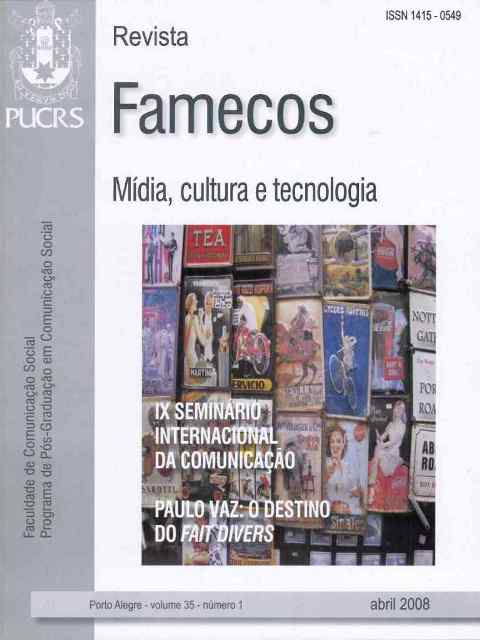Is there room for the sign in the history of media?
DOI:
https://doi.org/10.15448/1980-3729.2008.35.4094Keywords:
History of media, sign systems, cultural codesAbstract
There is a well known tradition refering to the social history of media based on the development of media in culture and in its effects on the social relationship scenary. That is the history focused on the set of technological inventions and its efficiency as means of communication. In the context of this approach there is no place to the study of language interaction. There are so many question we can put here and to consider as the main aim of this essay. The main question is: is there a place to sign in the social history of media? If we answer yes, another question should be considered: which is that place? In fact, the main point of this argumentation concern to the need of understanding not the history of media in general but the history of cultural codes in the process of mediation.Downloads
References
BAVCAR, Evgen. A luz e o cego. In: NOVAES, Adauto (org.). Artepensamento. São Paulo: Companhia das Letras, 1994.
BRIGGS, Asa & BURKE, Peter. Uma História Social da Mídia. De Gutenberg à Internet. Rio de Janeiro: Zahar, 2004.
CARPENTER, Edmund & McLUHAN. Revolução na comunicação. Rio de Janeiro: Zahar, 1980.
CASTELLS, Manuel. A sociedade em rede. A era da informação: economia, sociedade e cultura. Rio de Janeiro: Zahar, 1999.
COULMAS, Florian. The writing systems of the world. Cambridge, Blackwell, 1989.
GOODY, Jack & WATT, Ian. The consequences of Literacy, 1968. In Perspectives on Literacy (Eugene R. Kintgen e outros (orgs.). Carbondale and Edwardsville: Southern Illinois University Press, 1988.
JACOMY, Bruno. A era do controle remoto. Crônicas da inovação tecnológica (trad. Lucy Magalhães). Rio de Janeiro: Zahar, 2002.
JAKOBSON, Roman. Lingüística e comunicação. São Paulo: Cultrix, 1971.
LEMOS, André (org.). Cibercidade. As cidades na cibercultura. Rio de Janeiro: E-Papers, 2004.
_____. Cibercidade II. Ciberurbe. A cidade na sociedade da Informação. Rio de Janeiro: E-Papers, 2005.
_____. Cibercultura e mobilidade: a era da conexão. Razón y Palabra, México, n. 41, out./nov. Disponível em: www.cem.itesm.mx/dacs/publicaciones/logos/actual Acesso em: 19 out. 2004.
_____. Cidade Digital. Salvador: EDUFBa, 2007.
_____. Mídias locativas e territórios informacionais. In: SANTAELLA, Lucia; ARANTES, Priscila (orgs.). Estéticas tecnológicas. São Paulo: Educ, 2007.
LÉVY, Pierre. As tecnologias da inteligência. O futuro do pensamento na era da informática. Rio de Janeiro: Ed. 34, 1993.
LOTMAN, I.; USPENSKII, B.; IVANOV. Ensaios de Semiótica Soviética. Lisboa: Novo Horizonte, 1991.
LOTMAN, I. A estrutura do texto artístico. Lisboa: Estampa, 1978.
_____. The Universe of the Mind. A Semiotic Theory of Culture (trad. Ann Shukmann). Bloomington: Indiana University Press, 1990.
McLUHAN, Marshall. Os meios de comunicação como extensões do homem (trad. Décio Pignatari). São Paulo: Cultrix, 1971.
MARVIN, Carolyn. When Old Technologies Were New. Thinking About Eletric Communication in the Late Neneteenth Century. Oxford: Oxford University Press, 1988.
SONESSON, Göran. The Multimediation of the Lifeworld. Semiotics of the Media: state of the art, projects, and perspectives (Winfried Noth, ed.). Berlin-New York: Mouton de Gruyter, 1997.
VAZ, Paulo (2002). História das tecnologias cognitivas. Revista Fronteiras. Estudos Midiáticos, v. IV, n. 2, p. 101-120, dez. 2002.
WEINBERGER, D. (2003). Why Open Spectrum Matters. The end of the Broadcast Nation. Disponível em: http://www.evident.com Acesso em: 19 out. 2004.
WINSTON, Brian. Media Technology and Society. A History: from the Telegraph to the Internet. London and New York: Routledge, 1998.
Downloads
Published
How to Cite
Issue
Section
License
Copyright
The submission of originals to Revista Famecos implies the transfer by the authors of the right for publication. Authors retain copyright and grant the journal right of first publication. If the authors wish to include the same data into another publication, they must cite Revista Famecos as the site of original publication.
Creative Commons License
Except where otherwise specified, material published in this journal is licensed under a Creative Commons Attribution 4.0 International license, which allows unrestricted use, distribution and reproduction in any medium, provided the original publication is correctly cited.






